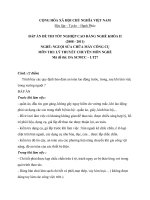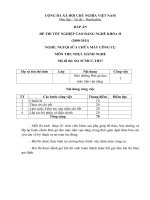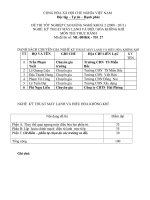PASSAGE 27
Bạn đang xem bản rút gọn của tài liệu. Xem và tải ngay bản đầy đủ của tài liệu tại đây (38.19 KB, 3 trang )
PASSAGE 27
According to airline industry statistics, almost 90 percent of airline accidents are survivable or partially
survivable. But passengers can increase their chances of survival by learning and following certain tips.
Experts say that you should read and listen to safety instructions before take-off and ask questions if you
have uncertainties. You should fasten your seat belt low on your hips and as tightly as possible. Of course,
you should also know how the release mechanism of your belt operates. During take-off and landings you
are advised to keep your feet flat on the floor.
Before take-off you should locate the nearest exit and an alternative exit and count the rows of seat
between you and the exits so that you can find them in the dark if necessary. In the event that you are
forewarned of the possible accident, you should put your hands on your ankles and keep your head down
until the plane come to complete stop. If smoke is present in the cabin, you should keep your head low
and cover your face with napkins, towels, or clothing. If possible, wet these for added protection against
smoke inhalation. To evacuate as quickly as possible, follow crew command and do not take personal
belongings with you. Do not jump on escape slides before they are fully inflated and when you jump, do
so with your arms and legs extended in front of you. When you get to the ground, you should move away
from the plane as quickly as possible, and never smoke near the wreckage.
Question 1. What is the main topic of the passage?
A. Safety instructions in air travel
B. Guidelines for increasing aircraft passengers survival.
C. Procedures for evacuating aircraft
D. Airline industry accident statistics.
Question 2. The word "evacuate" in the second paragraph is closest in meaning to___________
A. maintain
B. escape
C. vacate
D. return
Question 3. According to the passage, airline travellers should keep their feet flat on the
floor___________
A. during take-off and landings
B. throughout the flight
C. especially during landings
D. only if an accident is possible
Question 4. Airline passenger are to do all of the following EXCEPT___________
A. ask questions about safety
C. fasten their seat belt before take-off
B. carry personal belongings in an emergency
D. locate the nearest exit
Question 5. Travellers are urged by experts to read and listen to safety instructions___________
A. before locating the exits
B. in an emergency
C. if smoke is in the cabin
D. before take-off
Question 6. The word "inflated" in the second paragraph is closest in meaning to___________
A. lifted
B. assembled
C. increased
D. expanded
Question 7. According to the passage, which exits should an airline passenger locate before take-off?
A. The two closest to the passenger's seat
B. The ones that can be found in the dark.
C. The nearest one
D. The ones with counted rows of seats between them.
ĐÁP ÁN
1-B
2-B
6-D
7-A
3-A
4-B
5-D
LỜI GIẢI CHI TIẾT
Question 1:
Giải thích: Thơng tin nằm ở câu chủ đề: “But passengers can increase their chances of survival by
learning and following certain tips.”
Dịch nghĩa: Chủ đề chính của đoạn này là gì?
A. Hướng dẫn an tồn trong chuyến đi hàng không.
B. Hướng dẫn tăng sự sống sót của các hành khách máy bay.
C. Thủ tục di tản máy bay.
D. Số liệu thống kê tai nạn lao động ngành hàng khơng
Question 2:
Giải thích: evacuate: sơ tán, giải cứu
Dịch nghĩa: Từ " evacuate " trong đoạn thứ hai có ý nghĩa gần nhất với ........
A. duy trì
B. trốn thốt
C. bỏ lại
D. quay trở lại
Question 3:
Giải thích: Thơng tin nằm ở: “During take-off and landings you are advised to keep your feet flat on the
floor.”
Dịch nghĩa: Theo đoạn văn này, hanfh khách trên không nên giữ chân trên sàn nhà .......
A. Trong khi cất cánh và hạ cánh
B. trong suốt chuyến bay
C. đặc biệt là khi đổ bộ
D. chỉ khi xảy ra tai nạn
Question 4:
Giải thích: Thơng tin nằm ở: “To evacuate as quickly as possible, follow crew command and do not take
personal belongings with you.”
Dịch nghĩa: Hành khách đường hàng không phải làm tất cả những điều sau đây ngoại trừ .......
A. đặt câu hỏi về sự an toàn
B. mang đồ đạc cá nhân trong trường hợp khẩn cấp
C. buộc dây an toàn trước khi cất cánh
D. xác định vị trí lối ra gần nhất
Question 5:
Giải thích: Thơng tin nằm ở: “Experts say that you should read and listen to safety instructions before
take-off and ask questions if you have uncertainties”
Dịch nghĩa: Khách du lịch được các chuyên gia kêu gọi đọc và nghe hướng dẫn an toàn ........
A. Trước khi xác định điểm xuất cảnh
B. trong trường hợp khẩn cấp
C. nếu khói là trong cabin
D. trước khi cất cánh
Question 6:
Giải thích:
Dịch nghĩa: Từ " inflated " trong đoạn thứ hai là gần nghĩa nhất với .......
A. lifted: nâng, nhấc
B. assembled: thu thập
C. increased: gia tăng
D. expanded: mở rộng
Question 7:
Giải thích: Thơng tin nằm ở: “Before take-off you should locate the nearest exit and an alternative exit
and count the rows of seat between you and the exits so that you can find them in the dark if necessary”
Dịch nghĩa: Theo đoạn văn, điều gì hành khách nên định vị được trước khi cất cánh?
A. Hai chiếc gần chỗ ngồi của hành khách nhất.
B. Các chất có thể được tìm thấy trong bóng tối.
C. một trong những gần nhất.
D. những người có đếm hàng ghế giữa họ.









